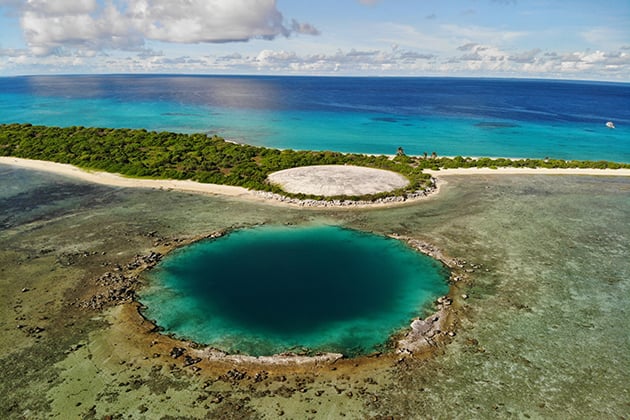The Runit Dome in the Marshall Islands contains more than 3.1 million cubic feet of radioactive soil and debris produced in the United States containing fatal levels of plutonium. What would be the consequences if the dome collapsed? Let us find out what happened to the Marshall Islands.
The US owes the Marshall Islands $2 billion for conducting nuclear tests there in 1946 that resulted in severe fallout. Many of the inhabitants and their descendants live in exile due to nuclear contamination.
The Marshall Islands
Micronesians first settled in the Marshall Islands around the beginning of the Christian period. Radiocarbon dates from earth-oven charcoal samples excavated in Laura village on Majuro ranged between 30 BCE and 50 CE. The early Marshall Islanders were adept navigators who traveled by canoe between the atolls.
The Marshall Islands were discovered in 1529 by the Spanish navigator lvaro Saavedra, but they lacked the richness to promote exploration or mapping. While traveling from Tahiti to Tinian, British captain Samuel Wallis came across the Rongerik and Rongelap atolls. The British naval captains John Marshall and Thomas Gilbert partially explored the Islands in 1788, but Russian expeditions led by Adam Johann Krusenstern and Otto von Kotzebue did most of the mapping.
From the 1820s, US whalers visited the islands, and by the 1850s, US and Hawaiian Protestant missionaries began efforts to convert the Islanders. Thanks to the treaty with the island chiefs, Germany created a coaling station on Jaluit Atoll. In 1886, by agreement with the United Kingdom, it formed a protectorate over the Marshall Islands.
Japan acquired the islands in 1914. It was managed as a League of Nations mandate after 1919. Following significant fighting at Kwajalein and Enewetak during World War II, the Marshall Islands constituted a part of the United Nations Trust Territory of the Pacific Islands under US jurisdiction in 1947.
After voting to secede from the Trust Territory of the Pacific Islands in 1978, the Marshall Islands drafted a constitution ratified by voters in 1979. It established the republic and provided internal self-government.
The government signed the Compact of Free Association with the US in 1982. This agreement, adopted by voters in 1983, mandates the US to continue to be responsible for defense and foreign security and give financial aid to the republic.
The UN Security Council approved the dissolution of the Trust Territory in 1990, and the Marshall Islands became a member of the UN on September 17, 1991. (Source: Britannica)
The Marshall Islands have approximately 72,000 people, with around 31,000 living in Majuro, the capital.
Coconuts and breadfruit are the mainstays of the island’s economy. Handicrafts, tuna processing, and copra are the only industries. Tourism has some promise. Natural resources are few on the islands and atolls, and imports outnumber exports. (Source: Economy)
The Betrayal of Marshall Islands
From 1946 to 1958, the islands of Bikini and Enewetak were used as an official testing area for US nuclear bombs. The United States launched 67 nuclear bombs on, in, and above the Marshall Islands, vaporizing entire islands, carving craters into its shallow lagoons, and displacing hundreds of people.
The testing was discontinued in 1958, and cleanup activities began in the late 1960s. However, during the experimental resettlement of the Bikinians, their atoll was too polluted for permanent habitation. By the late 1970s, the inhabitants had to be evacuated once more. The Enewetak people were restored to their country, and a monitoring program for Bikini was established. (Source: Britannica)
Later, US authorities cleaned up polluted soil on Enewetak Atoll, where the US conducted the majority of its weapons tests and a dozen biological weapons tests and deposited 130 tons of soil from a radioactive Nevada testing site. It then dumped the most dangerous debris and soil from the atoll into the dome.
The concrete coffin, dubbed the Tomb by locals, is now in danger of collapse due to the rising sea levels and other effects of climate change. Tides are creeping up its sides, rising higher each year as distant glaciers melt and sea levels rise.
Officials in the Marshall Islands have asked the United States government for assistance. Still, American officials have declined, claiming that the dome is on Marshallese territory and hence the responsibility of the Marshallese government.
Runit Dome is the most prominent expression of the United States’ nuclear legacy in the Republic of the Marshall Islands, a symbol of the Marshallese sacrifices for US security and the failed promises they received in return.
Marshallese leaders agree that America is not only to blame for their country’s plight. They believe, however, that the United States has failed to accept responsibility for the environmental disaster it has left behind and that US authorities have continually misled them about the severity and scope of the devastation. (Source: LA Times)
